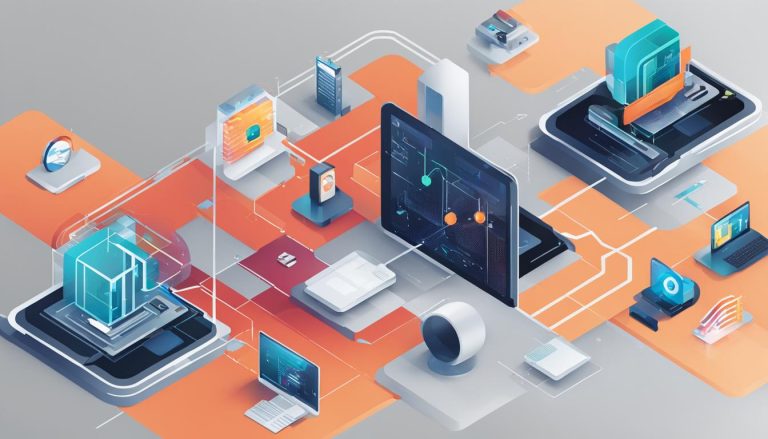Serverless computing has emerged as a popular paradigm in cloud computing, revolutionizing the way developers build applications. But what exactly is serverless computing? In this article, I will provide a comprehensive explanation of serverless computing, its benefits, and its implications for developers.
Serverless computing allows developers to focus solely on writing code for specific functions, known as Function-as-a-Service (FaaS), without the hassle of managing servers and infrastructure. This innovative approach frees developers from the burden of infrastructure management, allowing them to concentrate on the core application logic and deliver value to their users.
By employing serverless computing, developers can maximize cost savings, as they only pay for the actual function executions. Additionally, serverless architecture enables improved scalability, reduces operational overhead, and provides seamless integration with existing services offered by cloud vendors through Backend-as-a-Service (BaaS).
Key Takeaways:
- Serverless computing simplifies application development by eliminating the need for managing servers and infrastructure.
- Developers can focus on writing code for specific functions, optimizing resource utilization and enhancing scalability.
- Serverless computing offers cost savings, reduced operational overhead, and seamless integration with existing services.
- Major cloud vendors like AWS Lambda, Google Cloud Functions, Azure Functions, and Alibaba Cloud Function Compute provide serverless computing platforms with unique features.
- It is important for developers to evaluate the benefits and limitations of serverless computing before adopting it for specific use cases.
Understanding Serverless Architecture
Serverless architecture is a revolutionary model that simplifies application development and eliminates the need for managing servers, load balancing, and scaling infrastructure. With serverless computing, developers can focus solely on writing code for specific functions, known as Function-as-a-Service (FaaS). This paradigm shift allows developers to unleash their creativity and innovation, as they no longer need to worry about the underlying infrastructure.
One of the key benefits of serverless computing is the cost savings it offers. Developers only pay for the actual function executions, leading to optimized resource utilization. This pay-as-you-go pricing model significantly reduces operational costs, making serverless computing an attractive option for businesses of all sizes. Furthermore, serverless architecture enables improved scalability, as the underlying serverless platform takes care of scaling the application based on the number of incoming requests.
Another advantage of serverless architecture is the ability to integrate with existing services provided by cloud vendors through Backend-as-a-Service (BaaS). This allows developers to leverage pre-built functionalities, such as databases, authentication, and file storage, without having to develop and manage these services themselves. By utilizing these services, developers can accelerate the development process and focus on building the core business logic of their applications.
Serverless architecture is a game-changer for developers, enabling them to focus on what they do best – writing code and creating innovative applications. With reduced operational overhead, cost savings, improved scalability, and the ability to integrate with existing services, serverless computing is transforming the way applications are developed and deployed in the cloud.
Benefits of Serverless Computing
Serverless computing offers several benefits that make it an attractive choice for developers:
- Cost savings: With serverless architecture, developers only pay for the actual function executions, leading to optimized resource utilization and reduced operational costs.
- Improved scalability: The underlying serverless platform automatically scales the application based on the number of incoming requests, ensuring optimal performance even under high loads.
- Reduced operational overhead: Developers can focus solely on writing code, as the management of servers, load balancing, and scaling infrastructure is handled by the serverless platform.
- Integration with existing services: Serverless architecture allows developers to easily integrate with pre-built services provided by cloud vendors, accelerating the development process and enhancing functionality.
By harnessing the power of serverless architecture, developers can unlock new possibilities and create applications that are more efficient, scalable, and cost-effective.
| Benefits | Description |
|---|---|
| Cost Savings | With pay-as-you-go pricing, developers only pay for the actual function executions, leading to optimized resource utilization and reduced operational costs. |
| Improved Scalability | The underlying serverless platform automatically scales the application based on the number of incoming requests, ensuring optimal performance even under high loads. |
| Reduced Operational Overhead | Developers can focus solely on writing code, as the management of servers, load balancing, and scaling infrastructure is handled by the serverless platform. |
| Integration with Existing Services | Serverless architecture allows developers to easily integrate with pre-built services provided by cloud vendors, accelerating the development process and enhancing functionality. |
Comparing Serverless Computing vs Traditional Computing
Serverless computing is a revolutionary technology that differs significantly from traditional computing models. In traditional computing, developers are responsible for managing the infrastructure and scaling, which can be time-consuming and resource-intensive. However, serverless computing allows developers to focus solely on writing code, leaving the underlying serverless platform to handle infrastructure management. This technology enables developers to build applications faster and scale seamlessly without worrying about resource provisioning.
One of the key advantages of serverless computing is its ability to reduce operational burden. With traditional computing, developers need to spend time and effort managing servers, load balancing, and scaling infrastructure. In contrast, serverless computing abstracts away these complexities, allowing developers to focus on the core functionality of their applications. This results in reduced operational overhead and improved productivity.
Another significant difference between serverless computing and traditional computing is the cost model. In traditional computing, developers need to provision and manage resources upfront, which can lead to underutilization or over-provisioning. On the other hand, serverless computing follows a pay-per-use model, where developers only pay for actual function executions. This leads to optimized resource utilization and cost savings.
Table: Serverless Computing vs Traditional Computing
| Serverless Computing | Traditional Computing |
|---|---|
| Developers focus on writing code | Developers manage infrastructure |
| Reduced operational burden | Higher operational overhead |
| Pay-per-use cost model | Upfront resource provisioning |
| Improved scalability | Manual scaling |
| Increased development speed | Time-consuming infrastructure management |
End of Table
While serverless computing offers numerous benefits, it is important to consider its limitations as well. One limitation is the limited language support provided by serverless platforms. Developers may need to choose a platform that supports their preferred programming language. Additionally, certain languages may have cold start latency, which can impact the responsiveness of serverless functions.
Vendor lock-in is another consideration when comparing serverless computing to traditional computing. Developers need to carefully evaluate the services and features provided by different serverless platforms and consider the potential challenges of migrating applications between vendors.
In conclusion, serverless computing is a game-changer in the world of cloud computing. Its ability to simplify application development, reduce operational overhead, and optimize resource utilization makes it an attractive choice for developers. However, it’s essential to carefully evaluate the benefits and limitations of serverless computing before adopting it for specific use cases. By understanding the differences between serverless computing and traditional computing, developers can make informed decisions and leverage the full potential of serverless technology.
Exploring Serverless Computing Platforms
When it comes to serverless computing, major cloud vendors offer a range of platforms that provide developers with the necessary tools and resources to build and deploy serverless-based applications. These platforms, including AWS Lambda, Google Cloud Functions, Azure Functions, and Alibaba Cloud Function Compute, have unique features and capabilities that developers need to evaluate based on their specific application requirements.
To help developers make informed decisions, it is essential to understand the key features offered by each serverless computing platform. These features can include event triggers, support for multiple programming languages, monitoring and logging functionalities, and pricing models based on function runtime and resource consumption. By evaluating these features, developers can choose the platform that best aligns with their needs and objectives.
Furthermore, serverless computing platforms enable developers to leverage existing cloud services provided by the vendors. This allows for seamless integration with services like databases, storage, authentication, and messaging, through Backend-as-a-Service (BaaS) offerings. The ability to integrate with these services contributes to increased efficiency and agility in application development.
In summary, exploring serverless computing platforms is crucial for developers looking to adopt serverless architecture. Each platform offers unique features and capabilities that need to be considered based on specific application requirements. By leveraging these platforms, developers can streamline application development, optimize resource utilization, and take advantage of the benefits offered by serverless computing.
Understanding Serverless Computing Deployment and Use Cases
In this section, I will delve into the intricacies of serverless computing deployment and explore its various use cases. Deploying serverless functions involves packaging and uploading code to the serverless computing platform, allowing developers to focus solely on writing code and leaving infrastructure management to the platform.
When it comes to deployment, developers have the flexibility of choosing between uploading code as a local .ZIP file or accessing code from cloud storage or a source repository. This streamlined approach to deployment saves time and allows for rapid iteration and updates.
Now let’s move on to discussing the diverse use cases of serverless computing. This technology is suitable for a wide range of applications, including video processing, machine learning, and scientific computing. With serverless computing, developers can optimize resource consumption, enhance scalability, and improve the overall performance of their applications.
| Use Case | Description |
|---|---|
| Video Processing | A video streaming platform can leverage serverless computing to process and transcode videos on-demand, improving the user experience and reducing costs. |
| Machine Learning | Serverless computing enables developers to quickly deploy and scale machine learning models, making it easier to leverage AI capabilities in applications. |
| Scientific Computing | Researchers and scientists can harness the power of serverless computing for data analysis, simulations, and complex calculations, accelerating scientific discoveries. |
As demonstrated in Table 5, serverless computing offers a versatile solution for various industries and application domains. By leveraging serverless computing, developers can focus on building innovative, scalable, and cost-efficient solutions.
Examining Serverless Computing Examples
Serverless computing has revolutionized the way applications are developed and deployed across various industries. Let’s explore some real-world examples of how organizations are leveraging serverless computing to drive innovation and efficiency.
Video Streaming Platform
One popular use case for serverless computing is video processing and transcoding in a video streaming platform. Using serverless functions, the platform can process and transcode videos on-demand, providing a seamless streaming experience to users. This allows the platform to dynamically scale resources based on demand, ensuring efficient utilization and cost savings.
E-commerce Website
Serverless computing can also be utilized in e-commerce websites for inventory management and order processing. By leveraging serverless functions, these websites can efficiently handle inventory updates, automate order processing, and integrate with third-party services. This enables businesses to streamline their operations, improve customer experience, and scale their e-commerce platforms without managing infrastructure.
Chatbots and Virtual Assistants
Chatbots and virtual assistants are another area where serverless computing excels. Using serverless functions for natural language processing and response generation, developers can build intelligent chatbots and virtual assistants that can interact with users in real-time. This allows businesses to provide personalized and efficient customer support, automate repetitive tasks, and enhance user engagement.
Image recognition and Machine Learning
Serverless computing is also commonly used in image recognition and machine learning applications. By leveraging serverless functions for image processing and analysis, developers can build powerful applications that can classify images, detect objects, and perform complex machine learning tasks. This opens up opportunities for various industries, including healthcare, retail, and security, to harness the potential of serverless computing in their applications.
These examples highlight the versatility and flexibility of serverless computing in different domains. By eliminating the need for infrastructure management and providing on-demand scalability, serverless computing empowers developers to focus on building innovative applications that drive business growth and deliver seamless user experiences.
Benefits and Limitations of Serverless Computing
Serverless computing offers numerous benefits for developers and businesses, making it an increasingly popular choice in application development. By understanding the benefits and limitations of serverless computing, developers can make informed decisions and maximize the potential of this technology.
Benefits of Serverless Computing
One of the key benefits of serverless computing is the reduced operational overhead. Developers can focus on writing code for specific functions without the need to manage infrastructure. This allows for faster development cycles and increased productivity.
Cost savings are another advantage of serverless computing. With serverless architectures, developers only pay for the actual function executions, optimizing resource utilization and eliminating the need for upfront infrastructure investments. This pay-as-you-go model can result in significant cost reductions.
Improved scalability is also a major benefit of serverless computing. The underlying serverless platforms automatically handle load balancing and scaling, allowing applications to scale seamlessly based on demand. This ensures that applications can handle sudden spikes in traffic without manual intervention.
Limitations of Serverless Computing
While serverless computing offers many benefits, it also has some limitations that developers should consider. One limitation is the limited language support provided by serverless platforms. Different platforms may have different language support, so developers need to ensure that their preferred language is supported.
Cold start latency is another limitation of serverless computing, particularly for certain languages. When a function is triggered for the first time or after a period of inactivity, there may be a delay in its execution. This can impact real-time applications that require immediate response.
Potential vendor lock-in is also a consideration when adopting serverless computing. As developers build applications on specific serverless platforms, they become dependent on the services and features provided by those platforms. Switching to a different platform may require significant effort and migration efforts.
| Benefits | Limitations |
|---|---|
|
|
Despite these limitations, serverless computing remains a powerful solution for building scalable and cost-effective applications. It allows developers to focus on their core application logic while leveraging the benefits of cloud computing. By carefully evaluating the benefits and limitations, developers can make informed decisions and harness the full potential of serverless computing solutions.
Conclusion
In conclusion, serverless computing technology has revolutionized the way applications are developed and managed. With major cloud vendors offering serverless computing solutions, developers now have powerful platforms to simplify their workflow and focus on writing code. This paradigm eliminates the need for infrastructure management, allowing developers to optimize resource utilization and improve scalability.
Serverless computing holds immense potential for businesses and developers alike. It enables the creation of innovative applications across various industries, including video streaming, e-commerce, and virtual assistants. The cost savings, reduced operational overhead, and seamless integration with existing services make it an attractive option for application architecture.
However, it is important to carefully evaluate the benefits and limitations of serverless computing before adoption. Limited language support, cold start latency, and potential vendor lock-in are factors that developers need to consider. As serverless computing technology continues to evolve, it is crucial to stay updated with the latest advancements and choose the right platforms and solutions for specific use cases.
FAQ
What is serverless computing?
Serverless computing is a cloud computing paradigm where developers focus solely on writing code for specific functions, without the need for managing servers or infrastructure. It allows developers to build applications faster, scale seamlessly, and reduce operational overhead.
What are the benefits of serverless computing?
The benefits of serverless computing include cost savings, improved scalability, reduced operational overhead, and the ability to integrate with existing services provided by cloud vendors through Backend-as-a-Service (BaaS).
How does serverless computing differ from traditional computing models?
In traditional computing models, developers are responsible for managing infrastructure and scaling. In serverless computing, developers focus solely on writing code and rely on the underlying serverless platform to handle infrastructure management.
Which cloud vendors offer serverless computing platforms?
Major cloud vendors like AWS Lambda, Google Cloud Functions, Azure Functions, and Alibaba Cloud Function Compute offer their own serverless computing platforms.
What is serverless computing deployment?
Serverless computing deployment involves packaging and deploying functions to the serverless computing platform. Developers can choose between uploading code as a local .ZIP file or accessing code from cloud storage or a source repository.
What are some examples of serverless computing applications?
Serverless computing can be used for various applications, such as video processing, machine learning, scientific computing, inventory management, order processing, chatbots, and virtual assistants.
What are the benefits and limitations of serverless computing?
The benefits of serverless computing include reduced operational overhead, cost savings, improved scalability, and the ability to integrate with existing services. However, it also has limitations, such as limited language support, cold start latency, and potential vendor lock-in.
Claudia loves to discover the world and conquer new software products every now and then.


